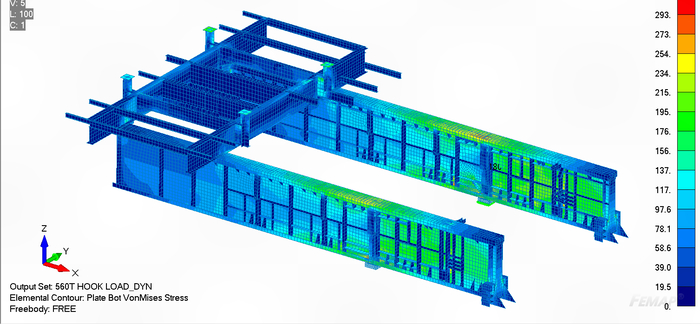Fast Finite Element Analysis (FEA), Structural Services

EMA performs structural analysis by using Finite element analysis, which is a tool suited for validation and optimization in all fields of engineering. Finite element analysis experience involving global models as well as micro-engineering aspects of connection details have been carried out to client satisfaction. Requirements of Finite element analysis arises in various engineering problems associated with offshore structures including new designs, conversions, upgrades, life extension, decommissioning etc. Various global or local finite element models are developed in these projects to accurately simulate the linear/non-linear structural responses under complex loading conditions. Robot 4, STAAD are just a few of the software that are employed by our experienced team of engineers for finite element applications.
Performing finite element analysis
(stress, thermal, vibration & fatigue) of equipment – ensuring structural integrity, performance and reliability. This includes the design of new equipment and the analysis of existing equipment – to Engineering Codes including AWS, API and ASME.
The benefits of performing finite element (FEA) include:
Determining a structure’s response to mechanical, vibratory and other loads, thus solving design challenges without arduous manual iterations or prototyping
Optimizing designs for weight and fabrication/ cost savings
We have performed FEA on numerous components including high-rise buildings, structural peer review of design, building element stress analysis, pressure vessels or petroleum delivery pipeline finite element analysis, bellows, decanters and skids – whether determining why they prematurely failed, or to ensure they last intended design life.
We also perform FEA Analysis to develop repair procedures on welded & non-welded structures – as well as on complex structures in elevated temperatures that may have thermal/transient and elastic/plastic stress effects. Our (design, analysis & troubleshooting) projects include applications in the energy, mining, petrochemical industries.
Existing structures represent a heterogeneous category in the global built environment as often characterized by the presence of archaic materials, damage and disconnections, uncommon construction techniques and subsequent interventions throughout the building history. In this scenario, the common linear elastic analysis approach adopted for new buildings is incapable of an accurate estimation of structural capacity, leading to over-conservative results, invasive structural strengthening, added intervention costs, excessive interference to building users and possible losses in terms of aesthetics or heritage values. For a rational and sustainable use of the resources, this book deals with advanced numerical simulations, adopting a practical approach to introduce the fundamentals of Finite Element Method, nonlinear solution procedures and constitutive material models. Recommended material properties for masonry, timber, reinforced concrete, iron and steel are discussed according to experimental evidence, building standards and codes of practice. The examples examined throughout the book and in the conclusive chapter support the analyst’s decision-making process toward a safe and efficient use of finite element analysis. Written primarily for practicing engineers, the book is of value to students in engineering and technical architecture with solid knowledge in the field of continuum mechanics and structural design.
Finite Element Analysis (FEA) Consulting
An understanding of structural dynamics is very important to sound Finite Element Analysis (FEA). We have been performing FEA analysis for over 20 years and in most cases we have used experimental data to guide our modeling. While our engineers have had undergraduate and graduate courses in FEA, it is the years of modeling and analysis of existing structures that has taught us the most by forcing a thoughtful analysis of the key structural dynamics and then going through the process of making adjustments to boundary conditions, expanding the dynamics of the model in places, and making simplifications and approximations where possible.
We perform many Static and Dynamic Analysis using FEA state of the art software and using various forcing functions (including time variant) with both modal superposition and numeric integration. For example, we looked at stress due to measured time domain wind loads on giant helio-static solar arrays.
Our FEA work has been for high-resolution fabrication and inspection equipment for the semiconductor and biotech industries for static, dynamic, and thermal finite element analysis.
https://foursquare.com/v/ema-structural-forensic-engineers/57e262aa498ef4c3cf0558a3
https://emaengineers.com/category/forensic-engineers-vero-beach/
https://www.fixr.com/sp.ema-structural-forensic-engineers.html
https://www.showmelocal.com/profile.aspx?bid=24613768
https://www.yelp.com/biz/ema-structural-forensic-engineers-orlando-5?osq=ema+engineers
